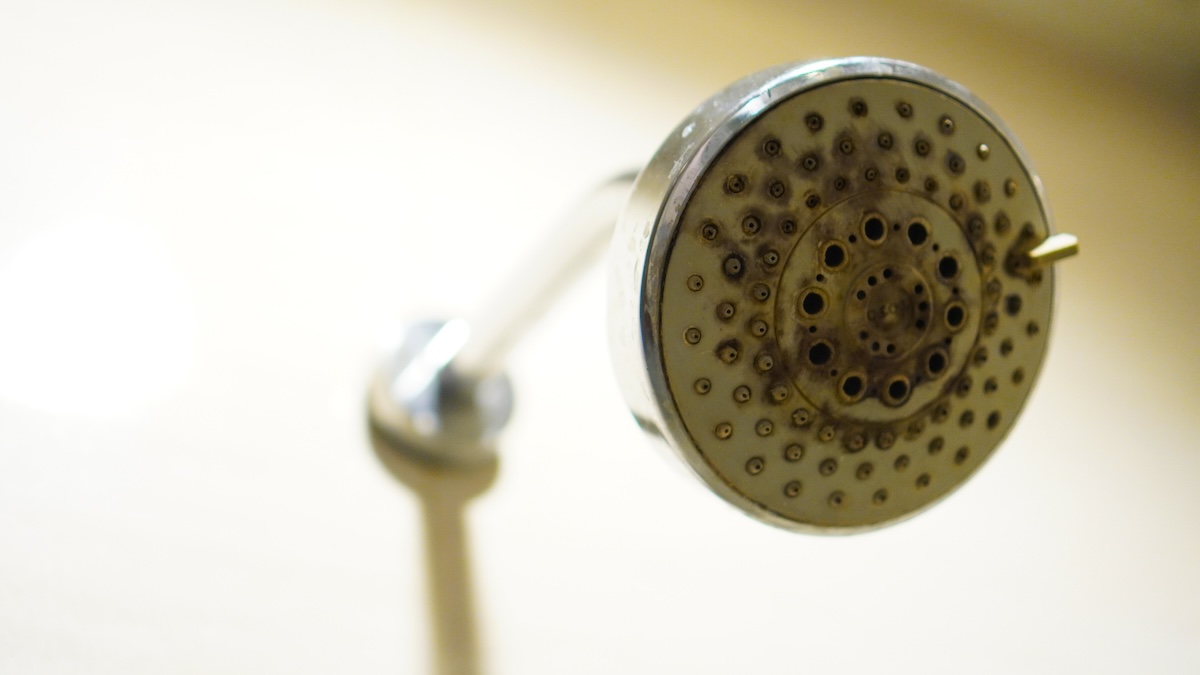

We may earn revenue from the products available on this page and participate in affiliate programs. Learn More ›
If you’re looking forward to a hot shower with an invigorating blast of water spray, you’ll understandably be disappointed if water trickles out or spurts sideways from your shower head. When new, a shower head delivers a uniform spray of water, but over time, the minerals in your water can begin to clog the tiny holes in the shower head, reducing the spray force and leaving you with a lackluster shower experience.
When your shower head fails to perform as well as it once did, it’s probably time to clean the shower head, eliminating scaly buildup within the fixture to restore the strength of its flow. Unclogging shower heads is easy to do, and you’ll be happy that you spent the small amount of time required with these solutions for cleaning shower heads and tips for preventing mineral buildup.
For a basic clean: Keep the shower head attached.

Though in many cases, it’s easy to remove and even change a shower head, not all heads unscrew easily. If they don’t, you’ll need to add a wrench and some elbow grease. Plus, a newer or well-maintained shower head might need a light cleaning only. Soaking a shower head by submerging it in an acidic solution—as simple as vinegar, a natural cleaner, will dissolve many of the hard water stains and deposits to descale your shower head.
So, for a quick and typically effective basic way for how to clean your shower head without taking it off, gather the materials listed below.
SUPPLIES
Distilled white vinegar (or commercial cleaner)
Baking soda
Ziploc bag
Rubber band or zip tie
Soft brush, if needed
Step 1: Measure and mix a vinegar and baking soda solution.
Handy pantry staples might be all you need; you can clean a shower head with vinegar and baking soda. The acids in vinegar (which has an average pH level of only 2) or some cleaners can dissolve the minerals that discolor and clog your shower head. If minerals are the only issue you can see with your shower head, you can try vinegar alone. Adding baking soda, which is a base and has an average pH of 9.5, can also help dissolve organic gunk like dirt and grease. That mix of the basic and acidic elements in a homemade shower cleaner addresses both minerals and grime and causes a fizzy chemical reaction, although the fizz is mostly for show.
To clean your shower head with vinegar, pour enough vinegar into a measuring cup or similar container to fill your Ziploc bag about half full. If you want to add baking soda, use just enough to dissolve organic grime and no more than 1 part for each 2 parts of vinegar. If you use equal amounts, the acid and base can cancel one another out. Or you can opt instead for a commercial cleaning solution if mineral deposits are particularly bad. Be sure to follow all safety and use instructions, including the product’s recommended surfaces, personal protection, and use of ventilation if necessary.
Step 2: Fill and attach the bag to the shower head.
Pour the cleaning solution from your measuring cup into a quart- or gallon-size Ziploc bag, filling the bag enough to submerge the entire shower head. Fold down the top edges of the bag and secure the bag around the shower head using a large rubber band, zip tie, or tape, making sure the head remains submerged.
Step 3: Let the shower head soak for several hours.
The length of time to soak the shower head depends on how many hard water deposits or other grime are on the surface. If you are simply doing a monthly soak to prevent hard-water buildup, about 30 minutes is probably long enough. But for a deep clean, leave the bag of vinegar in place for 4 to 8 hours, or even overnight.
Step 4: Remove the bag and wipe down the shower head.
After removing the bag, run the shower on full pressure to remove remaining deposits, clear out the vinegar, and check the spray. The soak should have softened any remaining deposits or grime so they should come off easily by just rubbing with a rag or rubbing the shower head with your thumb. If you need to clean the entire head after the soak, rub it gently with a toothbrush. Run the shower briefly once more to remove residue, especially if you soaked the head in a commercial cleaner.
For a deeper clean: Remove the shower head.

If the outside of your shower head has heavy mineral deposits, similar deposits could be present inside the shower head and on its filter screen. If you’ve observed reduced water pressure, haven’t cleaned the shower head in months, or know that your home has hard water, you might need to remove the shower head for a deep clean. Removing the head might be the best way to clean a clogged shower head, since you can both soak and scrub it well, and check and clean its screen filter.
SUPPLIES
Adjustable wrench (if necessary)
Rag or small cloth
Pliers (if necessary)
Tweezers or needle-nose pliers
Toothbrush or small nylon scrubbing brush
Bowl or pail
Distilled white vinegar
Baking soda
Small sewing needle or straight pin
Step 1: Remove the shower head.
It’s always best to check the manufacturer’s instructions first and consider the type of shower head when removing it. Most either unscrew from a threaded arm (the hose in handheld models) or have a nut that holds the head in place. First, try turning the head counterclockwise to see if it will unscrew easily.
If you need to use a wrench to unscrew a stuck shower head, protect the shower head’s finish by wrapping it in a rag or cloth and tying the cloth or holding it with pliers. Remove the shower head from the shower arm by twisting the threaded head or nut counterclockwise, holding the arm while you twist. Once a nut is loosened, you can simply unscrew the head. Watch for and set aside any screen or gasket that might be resting in the nut or the shower arm.
Step 2: Wipe away debris.
After detaching the shower head, wipe away any debris on the threads of the shower arm and from the head if necessary. Cover your finger with a rag and gently scrape each nozzle to remove visible buildup, being careful not to damage the rubber surface. Insert your finger into the threaded interior portion of the shower head to dislodge any debris. Rinse out debris with water.
Step 3: Remove the filter screen.
Again, consult the shower head maker’s instructions on how to remove and clean the filter screen if necessary. If you have not already located the screen, look in the threaded portion of the shower head that connects to the faucet pipe. Gently brush the screen out, noting its position. If it does not come out easily, use a pair of tweezers or needle-nose pliers to remove the filter gently. Clean the screen by rinsing it in water or by brushing it gently with a toothbrush while rinsing to remove mineral deposits on the screen.
Step 4: Submerge the shower head in distilled white vinegar or a cleaner that is safe for the finish.
Find a bowl that is at least as deep and wide as the shower head. Fill the bowl with distilled white vinegar (and a small amount of baking soda for noticeable grime) until the head is completely submerged. Let the head soak for at least an hour and up to overnight if it is clogged or heavily soiled.
Alternatively, you can use a shower head cleaner or mineral deposit cleaner. Be sure to check the cleaner’s safety precautions and follow instructions for soaking time. Harsh chemicals in some cleaners can damage shower head surfaces and also emit fumes. For example, some types of rust and lime deposit-removing cleaners (and toilet-bowl cleaners) will permanently mar chrome.
Step 5: Clean the head and open any clogged nozzles.
After soaking, you can gently brush the spray nozzles again with a toothbrush or soft nylon brush and baking soda paste or a quality shower cleaner that is safe for the surfaces. Ensure that you remove deposits from inside the nozzle holes by carefully pushing a small pin, paper clip, or needle through each hole. Rinse the shower head well again before reattaching it.
Step 6: Reinstall the shower head.
If you have removed a filter screen for cleaning, place it back in the same location. Turn the shower head clockwise to screw it back into place as tightly as possible with your hand. If you must use a wrench to tighten the head or nut, protect the finish again with a rag and avoid over-tightening the shower head, which could lead to damage and a leaking shower head. Test the shower head at high pressure for about a minute to clear remaining debris and cleaners.
How often should you clean your shower head?

The frequency with which you should cleaning your shower head depends partly on how hard your water is and how quickly it builds up on your shower head and other bathroom fixtures. In general, clean the shower head with vinegar every 1 to 2 months, using the method above that best suits your situation. This will prevent water flow problems and make it less necessary to scrub or soak overnight.
Shower Head Maintenance Tips
Prevent hard water stains, soap scum, and scale buildup on the outside of your shower head by spraying it with vinegar and wiping it down as part of your regular bathroom cleaning routine. That only addresses the outside, however, so scrub the shower head and nozzles regularly to prevent scale. Use vinegar or a similar nonabrasive cleaner that helps dissolve deposits and a soft nylon brush. This minimizes how often you will have to remove a shower head and soak it to unclog nozzles.
FAQ
Installing a water softener is an excellent idea if your home has naturally hard water. Not only will it help keep shower heads clear, but it will also prolong the useful life of your dishwasher and clothes washer. Plus, sinks, tubs, and showers will all need less cleaning.
Opt for a natural mold and mildew remover, such as Earthworm Mold Stain and Mildew Treatment.
If you’ve ever noticed a product called cleaning vinegar while shopping, you know that it looks similar to the typical distilled white vinegar that is considered a staple for both cooking and cleaning. However, the product labeled for cleaning has at least 6 percent acidity vs. the 5 percent typical of distilled white vinegar in a grocery food aisle. Most multipurpose cleaners also hover around 5 percent acidity.
The cleaning vinegar packs more punch but is not suitable for consumption, costs slightly more, and might prove too much for delicate surfaces. So, save the money and confusion by using regular distilled white vinegar from the condiment aisle.
